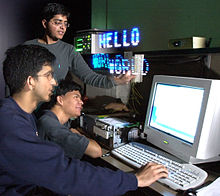ಹೆಲ್ಲೊ ವರ್ಲ್ಡ್ ಕಂಪ್ಯೂಟರ್ ಪ್ರೋಗ್ರ್ಯಾಮ್: ಪರಿಷ್ಕರಣೆಗಳ ನಡುವಿನ ವ್ಯತ್ಯಾಸ
ಚು →ಉಲ್ಲೇಖಗಳುs |
|||
| ೨೦ ನೇ ಸಾಲು: | ೨೦ ನೇ ಸಾಲು: | ||
* List of basic computer science topics |
* List of basic computer science topics |
||
* Trabb Pardo-Knuth algorithm |
* Trabb Pardo-Knuth algorithm |
||
==ಉಲ್ಲೇಖಗಳು== |
|||
==ಉಲ್ಲೇಖಗಳುs== |
|||
{{Reflist}} |
{{Reflist}} |
||
* {{ಟೆಂಪ್ಲೇಟು:Cite web|title=Hello World Collection |url=http://helloworldcollection.de |work=helloworldcollection.de |first=Wolfram |last=Rösler }} — with 450+ programs, plus "Hello World" in 60+ human languages |
* {{ಟೆಂಪ್ಲೇಟು:Cite web|title=Hello World Collection |url=http://helloworldcollection.de |work=helloworldcollection.de |first=Wolfram |last=Rösler }} — with 450+ programs, plus "Hello World" in 60+ human languages |
||
೧೪:೨೭, ೩೦ ಮಾರ್ಚ್ ೨೦೧೫ ನಂತೆ ಪರಿಷ್ಕರಣೆ



ಒಂದು "'ಹೆಲ್ಲೊ ವರ್ಲ್ಡ್!" ಪ್ರೋಗ್ರ್ಯಾಮು' ( "Hello, World!" program )' ತೋರುತೆರೆಯೊಂದರ ಮೇಲೆ "Hello, World!" ( ಅಥವಾ ಅಂತಹ ಬೇರೆ ಸಂದೇಶ ) ಎಂದು ತೋರಿಸುವ ಒಂದು ಕಂಪ್ಯೂಟರ್ ಪ್ರೊಗ್ರ್ಯಾಮ್ ಆಗಿದೆ. . ಬಹಳಷ್ಟು ಪ್ರೋಗ್ರ್ಯಾಮಿಂಗ್ ಭಾಷೆಗಳಲ್ಲಿ ಸಾಧ್ಯವಿರುವ ಬಲುಸರಳವಾದ ಪ್ರೋಗ್ರ್ಯಾಂ ಆದ ಕಾರಣ ಅದನ್ನು ಪ್ರೋಗ್ರ್ಯಾಮಿಂಗ್ ಭಾಷೆಯೊಂದನ್ನು ಕಲಿಯಲು ಆರಂಭಿಸುವವರಿಗೆ ಆ ಭಾಷೆಯ ಮೂಲ ರಚನೆಯನ್ನು ತೋರಿಸಿಕೊಡಲು ಬಳಸಲಾಗುತ್ತಿದೆ. ಒಂದು ಭಾಷೆ ಅಥವಾ ಕಂಪ್ಯೂಟರ್ ನ ಕಾರ್ಯಕಾರಿ ವ್ಯವಸ್ಥೆಯು ವ್ಯವಸ್ಥೆ ಯು ಸರಿಯಾಗಿ ಕೆಲಸ ಮಾದುತ್ತಿರುವುದನ್ನು ಖಚಿತಪಡಿಸಿಕೊಳ್ಳಲೂ ಅದನ್ನು ಬಳಸಲಾಗುತ್ತದೆ.
ಉದ್ದೇಶ
A "Hello, world!" program has become the traditional first program that many people learn. In general, it is simple enough so that people who have no experience with computer programming can easily understand it, especially with the guidance of a teacher or a written guide. Using this simple program as a basis, computer science principles or elements of a specific programming language can be explained to novice programmers. Experienced programmers learning new languages can also gain a lot of information about a given language's syntax and structure from a "Hello, world!" program.
In addition, "Hello, world!" can be a useful sanity test to make sure that a language's compiler, development environment, and run-time environment are correctly installed. Configuring a complete programming toolchain from scratch to the point where even trivial programs can be compiled and run can involve substantial amounts of work. For this reason, a simple program is used first when testing a new tool chain.
ಇತಿಹಾಸ
While small test programs existed since the development of programmable computers, the tradition of using the phrase "Hello, world!" as a test message was influenced by an example program in the seminal book The C Programming Language[citation needed]. The example program from that book prints "hello, world" (without capital letters or exclamation mark), and was inherited[citation needed] from a 1974 Bell Laboratories internal memorandum by Brian Kernighan, Programming in C: A Tutorial,[೧] which contains the first known version:
Variations
There are many variations on the punctuation and casing of the phrase. Variations include the presence or absence of the comma and exclamation mark, and the capitalization of the 'H', both the 'H' and the 'W', or neither. Some languages are forced to implement different forms, such as "HELLO WORLD!", on systems that support only capital letters, while many "hello world" programs in esoteric languages print out a slightly modified string. For example, the first non-trivial Malbolge program printed "HEllO WORld", this having been determined to be good enough.
There are variations in spirit, as well. Functional programming languages, like Lisp, ML and Haskell, tend to substitute a factorial program for Hello World, as functional programming emphasizes recursive techniques, whereas the original examples emphasize I/O, which violates the spirit of pure functional programming by producing side effects.
The Debian and Ubuntu Linux distributions provide the "hello world" program through the apt packaging system; this allows users to simply type "apt-get install hello" for the program to be installed, along with any software dependencies. While of itself useless, it serves as a sanity check and a simple example to newcomers of how to install a package. It is significantly more useful for developers, however, as it provides an example of how to create a .deb package, either traditionally or using debhelper, and the version of hello used, GNU Hello, serves as an example of how to write a GNU program.
ಇವನ್ನೂ ನೋಡಿ
- List of Hello world program examples
- "99 Bottles Of Beer" as used in computer science
- Foobar
- Just another Perl hacker
- List of basic computer science topics
- Trabb Pardo-Knuth algorithm
ಉಲ್ಲೇಖಗಳು
- ↑ "Programming in C: A Tutorial" (PDF).
- Rösler, Wolfram. "Hello World Collection". helloworldcollection.de. — with 450+ programs, plus "Hello World" in 60+ human languages
- Hosey, Peter. "Hello World, cut four ways: How to write good (and bad) programs". boredzo.org.
- "Unsung Heroes of IT / Part One: Brian Kernighan". TheUnsungHeroesOfIT.com.
- "HelloData: A Simple ADO Application". MSDN. Microsoft.
